January 20, 2021, Vancouver, Canada – Jaxon Mining Inc. (“Jaxon” or the “Company”) (TSX.V: JAX, FSE: OU31, OTC: JXMNF) is pleased to announce the results of the petrographic and mineral studies of the Netalzul Mountain Project conducted by John G. Payne, Ph.D., P.Geo. of Surrey, British Columbia, Canada, and Minghua Ren, Ph.D., from the University of Nevada, Las Vegas, Nevada, USA. The studies confirm Jaxon’s discovery of intermediate sulfidation (IS) type epithermal Ag-Cu-Au polymetallic deposits at Netalzul Mountain are analogous to both the Blackwater type and Brucejack type deposits. All are set in the same Stikinia Terrane (Figure 1) in northwestern B.C., Canada.
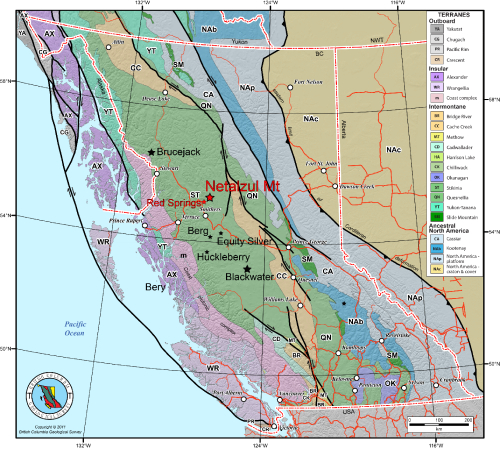
Figure 1. Map of British Columbia showing relevant accreted terranes within the Intermontane and Insular Belts. Modified from Sean P. Tombe (2015)
Highlights of Petrographic and Mineral Studies at Netalzul Mountain Project
- Samples A0020737 and A0020740 from Daisy North Contact Zone are identified as massive sulfide quartz vein Ag-Cu-Zn-Pb-Sb mineralization within an altered and replaced latite at the contact zone between Bulkley intrusion and Middle to Upper Jurassic Bowser Lake Group. It is a green sericite-pyrite-quartz rocks assemblage, typical in the Stikinia Terrane, which is same as the host rocks at the Blackwater and the Brucejack deposits.
- Samples A0027242, A0027244 and A0027245 from Daisy South Adit Zone are sulfide quartz vein Au-Cu-Ag mineralization and contain more gold and copper components than in Daisy North Contact Zone. The general mineral assemblage is similar to that in Daisy North Contact Zone, but with different percentages. It may represent a lower temperature and shallow sections of the epithermal vein system.
- Sample A0027521 from Daisy East Zone has been identified as a sulfide quartz vein hosted in a slightly metamorphosed granodiorite which shows quartz-chlorite-sericite-calcite-kaolinite alteration, 0.5 % magnetite and 1-2% pyrite and different amounts of chalcopyrite. It may be an early phase magmatic high hydrous granodiorite with quick cooling down sulfide mineralization veins. The high-grade Cu materials were identified as hematite under microscope but was recognized as an amorphous, solidified colloidal Cu-Fe material or a mixture of amorphous malachite and hematite/limonite based on their geochemical characteristics (Figure 7, Table 5).
- Intermediate-sulfidation (IS) deposits typically with stability of chalcopyrite, (Ag)-tetrahedrite-tennantite, Mn-rich calcite and FeS-poor sphalerite, lacking appreciable arsenopyrite and pyrrhotite, all of these features have been found at the Netalzul Mt project (Figure 2-6, Table 2-4). The mineral assemblage of Fe-poor sphalerite, Ag-rich tetrahedrite/tennantite, Mn-rich calcite is typical of an intermediate sulfidation epithermal Ag-Cu-Au-Pb-Zn polymetallic deposit and is an analogue to the Fresnillo Silver deposit in Mexico, the Blackwater/Capoose deposits in central BC and the Brucejack deposit in northwest B.C. (Table 6).
- Netalzul Mountain project is a typical IS epithermal silver-rich Ag-Cu-Au-Pb-Zn deposit and is potentially related to a deep porphyry system (Figure 8)
Mr. John King Burns, CEO and Chairman of Jaxon Mining, commented, “Jaxon is planning an aggressive 2021 drill program to test Netalzul and then Red Springs. The locations and detailed designs for drilling activity will be announced Q2 of 2021. With two years of systematic and multi-disciplinary work, we have removed the risk and leveraged this drill program. Our targets are fully geologically informed, and we have used our models to generate the vectors for our drill targets.”
“76 holes were drilled before Hemlo was taken seriously, and 109 holes before Eskay Creek was recognized as a significant discovery. Our drill program, as designed, when funded, should allow us to drill define more than one equally significant discovery at Netalzul Mt. with fewer than 20 drill holes.”
“Jaxon continues to study and accumulate more data from the petrological and lithological examination of the rocks that host our targets. The geochronologies derived from the rock dating and thermometry results confirm Jaxon’s understanding of the development of the settings for and the composition of the rocks that make up our targets. We continue to integrate these results and additional data into our conceptual geological models. The results of our geological modeling continue to drive us to selectively expand and connect our claims at Hazelton.”
“Jaxon views both Netalzul Mt. and Red Springs as structural traps that collected huge volumes of metalliferous fluids produced during the series of accretionary orogenic, Laramide-like, mountain building events that impacted the Skeena Arch and generated all of our targets at Hazelton. We expect the 2021 drill program to produce dramatic and positive results and to demonstrate that one or both Netalzul Mt. and Red Springs hosts the volumes of structurally controlled mineralization necessary to support the development of economic and responsible Cu, Ag and Au polymetallic mining operations.”
During the 2020 field season, Jaxon’s geologists discovered three structurally controlled zones with high-grade polymetallic sulfide mineralization at the Netalzul Mt. Project, previously announced October 7, 2020 (https://bit.ly/2NbsbhD).
Seven rock samples from these three mineralization zones were studied using a conventional microscope (Figures 2-5, Table 1). The full petrographic study report is available at https://jaxonmining.com.
As part of the study of the minerals and their chemical compositions, all thin sections were analyzed using Electron Probe Micro Analyzer (EPMA) and Scanning Electron Microscope (SEM). Backscattered Electron (BSE) images and quantitative analyses of EPMA and qualitative SEM/EDS data were collected. Sphalerite, tetrahedrite and calcite from samples A0020737 and A0020740, hematite and unrecognized copper minerals (under microscope) from A0027521 were the focus. The study confirms the existence of Fe-poor sphalerite, Ag-rich tetrahedrite/tennantite, Mn-rich calcite at Daisy North Contact Zone and Daisy South Adit Zone (Figure 6, Tables 2-4). The “hematite” under microscope may be the colloid of Fe-Cu elements (or the amorphous mixture of malachite and hematite). The unrecognized black minerals are chalcocite (Figure 7, Table 5).
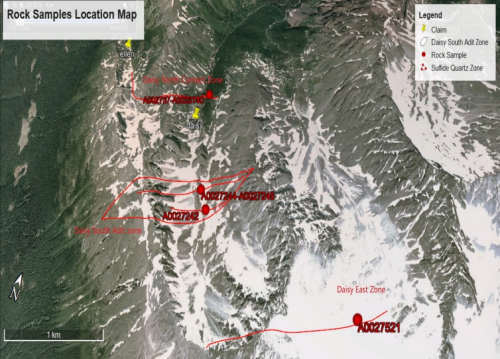
Figure 2. Sample locations and sulfide quartz mineralization zones at Netalzul Mt. Project.
Table 1: Sample Details from Petrographic and Fire Assay Studies
| Sample ID | Sample location area | Rock types | Ag/Au/Cu assay (ppm) | Sulfide minerals (%) | Alteration Minerals |
| A0027242 | Grab sample, Daisy South Adit Zone | Sulfide quartz vein | 623/5.9134570 | tetrahedrite/tennantite, 17-20, galena 7-8, pyrite 0.4, chalco-py 0.2, barite 0.1, sphalerite <0.1 | pyrite barite |
| A0027244 | Outcrop, Daisy South Adit Zone | Sulfide quartz vein | 93/0.737510 | chalcopyrite 7-8, pyrite 2-3, molybdenite 0.5, tetrahedrite/tennantite 0.1 | pyrite |
| A0027245 | Outcrop, Daisy South Adit Zone | Sulfide quartz vein | 90/0.397480 | molybdenite 5- 7, pyrite 2-3, | Pyrite |
| A0020737 | Grab sample, Daisy North Contact Zone | Latite/Massive Sulfide vein | 5301/0.4533460 | sphalerite 20-75, tetrahedrite/tennantite 3-35, chalco-py 0.1-2, galena 0.3-3, pyrite -minor | chlorite calcite sericite |
| A0020740 | Outcrop, Daisy North Contact Zone | Latite/massive sulfide vein | 4577/0.4830390 | sphalerite 2-25, tetrahedrite/tennantite 5-30, chalco-py 1-2, galena 3-15, pyrite -minor | chlorite, sericite, calcite |
| A0027521-1 | Grab sample, Daisy East Zone | Sulfide quartz vein | 75/0.0720020 | chalcopyrite 40-45, pyrite 8-10, malachite, 3-5, hematite 5-7, mineral A (Chalcocite), 2-3 | malachite, hematite |
| A0027521-2 | Granodiorite | magnetite 0.5, chalcocite minor | chlorite, actinolite |

Figure 3. Sample A0027242, thin section showing quartz (qz), galena (gl), tetrahedrite (tt) and chalcopyrite (cp).
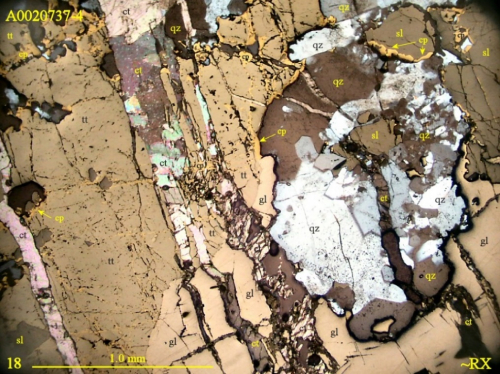
Figure 4. Sample A0020737, thin section showing quartz (qz), tetrahedrite (tt), chalcopyrite (cp), sphalerite (sp), calcite (ct) and galena (gl).
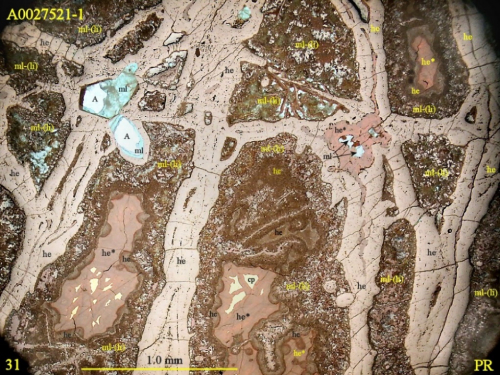
Figure 5. Sample A0027521, thin section showing pyrite (py), hematite (he), chalcopyrite (cp), malachite (mi), a mineral (chalcocite) and limonite (li).

Figure 6. EPMA BSE image of sample A0020737: sph-sphalerite, gln-galena, teh-tetrahedrite, Cc-calcite and Qz-quartz.
Table 2. Chemical Composition of Ag-rich Tetrahedrite/Tennantite in Sample A0020737
| No. | 20 | 22 | 26 | 29 | 31 | 32 | 34 | 36 | 38 | 39 | 43 | 44 |
| Comment | 737-1 5 | 737-1 7 | 737-1 11 | 737-1 14 | 737-1 16 | 737-1 17 | 737-1 19 | 737-1 21 | 737-1 23 | 737-1 24 | 737-1 28 | 737-1 29 |
| S | 24.37 | 24.21 | 24.12 | 23.90 | 23.96 | 24.42 | 23.84 | 24.42 | 24.58 | 24.26 | 23.89 | 23.76 |
| As | 0.00 | 0.00 | 0.06 | 0.06 | 0.01 | 0.05 | 0.00 | 0.06 | 0.00 | 0.02 | 0.00 | 0.00 |
| Fe | 0.67 | 0.42 | 0.42 | 0.47 | 0.41 | 0.43 | 0.33 | 0.43 | 0.51 | 0.49 | 0.51 | 0.45 |
| Mn | 0.00 | 0.04 | 0.00 | 0.02 | 0.02 | 0.00 | 0.00 | 0.00 | 0.03 | 0.02 | 0.03 | 0.02 |
| Cu | 36.35 | 36.03 | 35.35 | 35.23 | 36.50 | 37.20 | 35.28 | 36.23 | 37.42 | 37.00 | 36.02 | 35.73 |
| Sb | 27.20 | 27.43 | 27.52 | 28.82 | 27.40 | 26.18 | 29.40 | 28.03 | 26.34 | 26.13 | 27.12 | 27.18 |
| Ag | 5.14 | 5.51 | 6.29 | 6.08 | 4.82 | 4.35 | 5.82 | 5.13 | 4.07 | 4.59 | 5.39 | 5.98 |
| Au | 0.00 | 0.09 | 0.07 | 0.07 | 0.03 | 0.00 | 0.00 | 0.00 | 0.00 | 0.00 | 0.00 | 0.02 |
| Pb | 0.04 | 0.09 | 0.04 | 0.02 | 0.00 | 0.07 | 0.05 | 0.11 | 0.00 | 0.00 | 0.00 | 0.00 |
| Zn | 6.94 | 7.38 | 6.96 | 7.03 | 7.30 | 7.29 | 7.38 | 7.10 | 7.40 | 7.30 | 7.34 | 7.23 |
| Hg | 0.00 | 0.00 | 0.03 | 0.20 | 0.00 | 0.21 | 0.12 | 0.12 | 0.05 | 0.40 | 0.00 | 0.53 |
| Mo | 0.54 | 0.40 | 0.46 | 0.48 | 0.39 | 0.50 | 0.36 | 0.45 | 0.41 | 0.40 | 0.47 | 0.58 |
| Bi | 0.02 | 0.00 | 0.15 | 0.02 | 0.03 | 0.17 | 0.00 | 0.00 | 0.00 | 0.00 | 0.00 | 0.00 |
| Tl | 0.00 | 0.00 | 0.00 | 0.00 | 0.00 | 0.00 | 0.00 | 0.00 | 0.05 | 0.00 | 0.02 | 0.00 |
| Total | 101.27 | 101.59 | 101.47 | 102.38 | 100.86 | 100.87 | 102.59 | 102.08 | 100.85 | 100.61 | 100.78 | 101.48 |
Table 3. Chemical Composition of Fe-poor Sphalerite in Sample A0020737
| No. | 16 | 23 | 24 | 28 | 41 | 42 |
| Comment | 737-1 1 | 737-1 8 | 737-1 9 | 737-1 13 | 737-1 26 | 737-1 27 |
| S | 32.66 | 33.15 | 32.82 | 32.86 | 33.07 | 32.12 |
| As | 0 | 0 | 0 | 0 | 0 | 0 |
| Fe | 0.07 | 0.08 | 0.09 | 0.68 | 0.06 | 0.06 |
| Mn | 0 | 0 | 0 | 0.00 | 0.00 | 0.02 |
| Cu | 0 | 0 | 0 | 0.74 | 0.00 | 0 |
| Sb | 0.01 | 0 | 0 | 0 | 0 | 0.06 |
| Ag | 0 | 0 | 0.01 | 0 | 0.04 | 0 |
| Au | 0.04 | 0 | 0.02 | 0.03 | 0 | 0.05 |
| Pb | 0.05 | 0.05 | 0.03 | 0.02 | 0.06 | 0.00 |
| Zn | 65.61 | 65.97 | 65.62 | 67.74 | 67.75 | 66.79 |
| Hg | 0 | 0.07 | 0.13 | 0.2 | 0.12 | 0.07 |
| Mo | 0.59 | 0.63 | 0.55 | 0.64 | 0.62 | 0.61 |
| Bi | 0.02 | 0.05 | 0.07 | 0.01 | 0.09 | 0.03 |
| Tl | 0 | 0 | 0 | 0 | 0 | 0 |
| Total | 99.06 | 100.00 | 99.34 | 102.90 | 101.81 | 99.81 |
Table 4. EDS Chemical Composition of Calcite in Sample A0020737
| Element | Weight% | Atomic% | Compd% | Formula |
| C | 10.90 | 18.91 | 39.93 | CO2 |
| Ca | 36.99 | 19.24 | 51.75 | CaO |
| Mn | 5.14 | 1.95 | 6.63 | MnO |
| As | 1.28 | 0.36 | 1.69 | As2O3 |
| O | 45.70 | 59.55 | ||
| Totals | 100.00 |
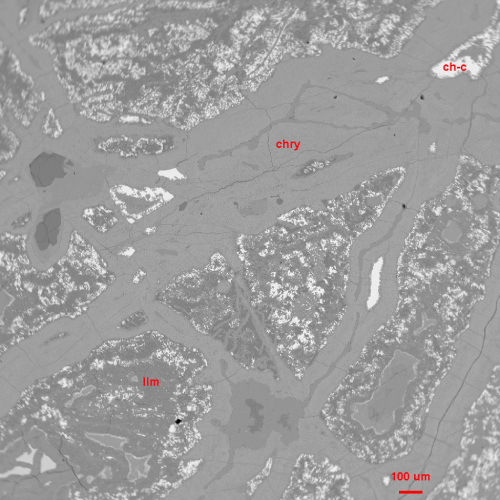
Figure 7. BSE image of sample A0027521, chry, unidentified Cu-Fe-phase, ch-c, chalcocite; llm, limonite.
Table 5. Chemical Composition of “Hematite”—Unidentified Cu-Fe phase in Sample A0027521
| No. | 44 | 47 | 52 | 53 | 65 |
| Comment | 521-1 Fe 13 | 521-1 Fe 16 | 521-1 ch-p 21 | 521-1 ch-p 22 | 521-1 ch-p 34 |
| S | 0.81 | 0.21 | 0.54 | 0.7 | 1.40 |
| As | 0 | 0 | 0 | 0 | 0 |
| Fe | 32.67 | 41.11 | 34.5 | 34.14 | 15.44 |
| Mn | 0.00 | 0.00 | 0.01 | 0.02 | 0.01 |
| Cu | 20.69 | 10.70 | 18.52 | 18.46 | 34.51 |
| Sb | 0 | 0 | 0 | 0 | 0 |
| Ag | 0.01 | 0 | 0.00 | 0 | 0 |
| Au | 0.22 | 0 | 0.00 | 0.03 | 0 |
| Pb | 0.02 | 0.15 | 0 | 0 | 0.00 |
| Zn | 0.1 | 0.37 | 0.15 | 0.08 | 0.17 |
| Hg | 0.06 | 0 | 0 | 0.24 | 0 |
| Mo | 0.06 | 0.09 | 0 | 0.07 | 0 |
| Bi | 0.05 | 0.02 | 0 | 0 | 0 |
| Tl | 0 | 0 | 0 | 0.02 | 0 |
| Si | 1.11 | 4.63 | 1.58 | 2.04 | 9.21 |
| Al | 0 | 0 | 0.016 | 0 | 0 |
| Se | 0.01 | 0.02 | 0.00 | 0.02 | 0.04 |
| Co | 0.06 | 0.08 | 0.08 | 0.04 | 0.01 |
| Ni | 0 | 0 | 0 | 0.013 | 0.008 |
| Total | 55.87 | 57.38 | 55.4 | 55.87 | 60.8 |
The variation of the chemistry from different point indicates this could be a solidified Fe-Cu colloid or a mixture of malachite and hematite/limonite.
Table 6. Comparison of Netalzul Project with Blackwater and Brucejack Deposits
| Deposit | Blackwater/Capoose | Netalzul Mt | Brucejack |
| Crustiform/cockade quartz vein, open space fillings | Yes | Yes | Yes |
| Fe-poor sphalerite, tetrahedrite-tennantite, chalcopyrite | Yes | Yes | Yes |
| Elevated Au-Ag-Zn-Cu-Pb-As | Yes | Yes | Yes |
| Scarce arsenopyrite, absence of pyrrhotite | Yes | Yes | Yes |
| Bulkley Intrusion | Yes | Yes | No |
| Green sericite-pyrite-quartz | Yes | Yes | Yes |
| Vertical Extent Mineralization | >600m | >? | >1000m |
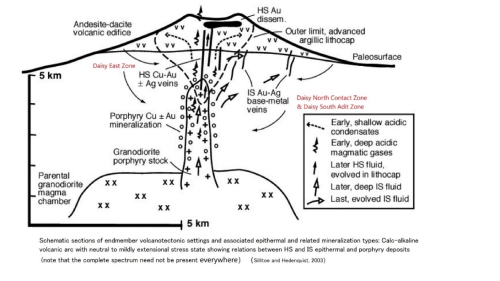
Figure 8. Conceptual Model of Netalzul Moutain IS Type Epithermal Deposit
Sample Preparation and Analyses
All samples described in this news release were collected by the Company’s Qualified Professional Geologists. The thin sections of all the samples were prepared by Vancouver GeoTech Labs of Unit #155 – 11951 Mitchell Road Richmond, B.C., Canada and Van Petro Inc., 8080 Glover Road, Langley, B.C. The thin sections were described by Professional Geoscientist (Ph.D.), John Payne of Surrey, B.C., Canada.
Rock samples were collected in the field by experienced, professional prospectors and geological staff who selected hand samples from outcrop, chip samples, boulder and talus debris samples suitable for slabbing by rock saw. The samples were numbered, described and located in the field for follow-up. Numbered rock sample tags were placed inside each bag and securely closed for transport to the Company’s secure cold storage locked facility in Smithers, B.C. Representative sample slabs were cut from large specimens and halved rock samples so that portions of select samples could be saved for the Company’s rock library, descriptive purposes and petrographic study. MS Analytical of Langley, B.C. received the Rice Bag shipments after secure transport from Smithers. Samples were prepared by crushing, grinding and pulverizing to a pulp with barren material washing between each sample at the crush and pulverizing stages. Then 20 g of pulp was used for the (IMS-117 code) ultra-trace level ICP/MS AR digestion method, and four acid 0.2 g ore grade ICP – AES method (ICP-240) and for the overlimit gold the FAS-415 method of 30 g fusion Gravimetric method was used to report gold ASSAYS. Overlimit silver is determined by Fire ASSAY 415 method. Laboratory standards and QA – QC is monitored by the Company.
Methodology for EPMA Analyses of Sulfides
Sulfides were analyzed using a JEOL electron probe microanalyzer JXA-8900 (EPMA) at the University of Nevada, Las Vegas Electron Microanalysis and Imaging Laboratory operated with the following probe conditions: accelerating voltage of 15 kV, beam current 20nA, and focused beam. Au was counted for 80 seconds on peak and 20 seconds on each background. Au Lα x-ray is selected for Au analysis to minimize the interference from other elements, and the detection limit is around 90-125 ppm. Ag was counted 40 seconds on peak and 15 seconds on each background, and all other elements were counted 30 second on peak and 15 seconds on background. Au, Ag, As, Mo, Bi, Co, and Ni use pure metal standards, other elements use correlated sulfide minerals except Mn, Si and Al. Mn uses ilmenite, Si and Al use plagioclase as their standards.
Qualified Person
Yingting (Tony) Guo, P.Geo., President and Chief Geologist of Jaxon Mining Inc., a Qualified Person as defined by National Instrument 43-101, has reviewed and prepared the scientific and technical information and verified the data supporting such scientific and technical information contained in this news release.
About Jaxon Mining Inc.
Jaxon is a precious and base metals exploration company with a regional focus on Western Canada. The Company is currently focused on advancing its Netalzul Mt. and Red Springs Projects in north-central British Columbia.
ON BEHALF OF THE BOARD OF DIRECTORS
JAXON MINING INC.
“John King Burns”
John King Burns, Chairman
For more information please contact:
Investor Relations
Kaye Wynn Consulting
T: 604-558-2630
TF: 1-888-280-8128
E: info@kayewynn.com
Freeform Communications
T: 604-243-0499
E: enquiries@freeform.com
Corporate
T: 604-424-4488
E: info@jaxonmining.com
https://jaxonmining.com
This news release may contain forward-looking information, which is not comprised of historical facts. Forward-looking information involves risks, uncertainties and other factors that could cause actual events, results, performance, prospects and opportunities to differ materially from those expressed or implied by such forward-looking information. Forward-looking information in this news release may include, but is not limited to, the Company’s objectives, goals or future plans. Factors that could cause actual results to differ materially from such forward-looking information include, but are not limited to, those risks set out in the Company’s public documents filed on SEDAR. Although the Company believes that the assumptions and factors used in preparing the forward-looking information in this news release are reasonable, undue reliance should not be placed on such information, which only applies as of the date of this news release, and no assurance can be given that such events will occur in the disclosed time frames, or at all. The Company disclaims any intention or obligation to update or revise any forward-looking information, whether as a result of new information, future events or otherwise, other than as required by law. Neither TSX Venture exchange nor its Regulations Services Provider (as that term is defined in the policies of the TSX Venture Exchange) accepts responsibility for the adequacy or accuracy of this release.
